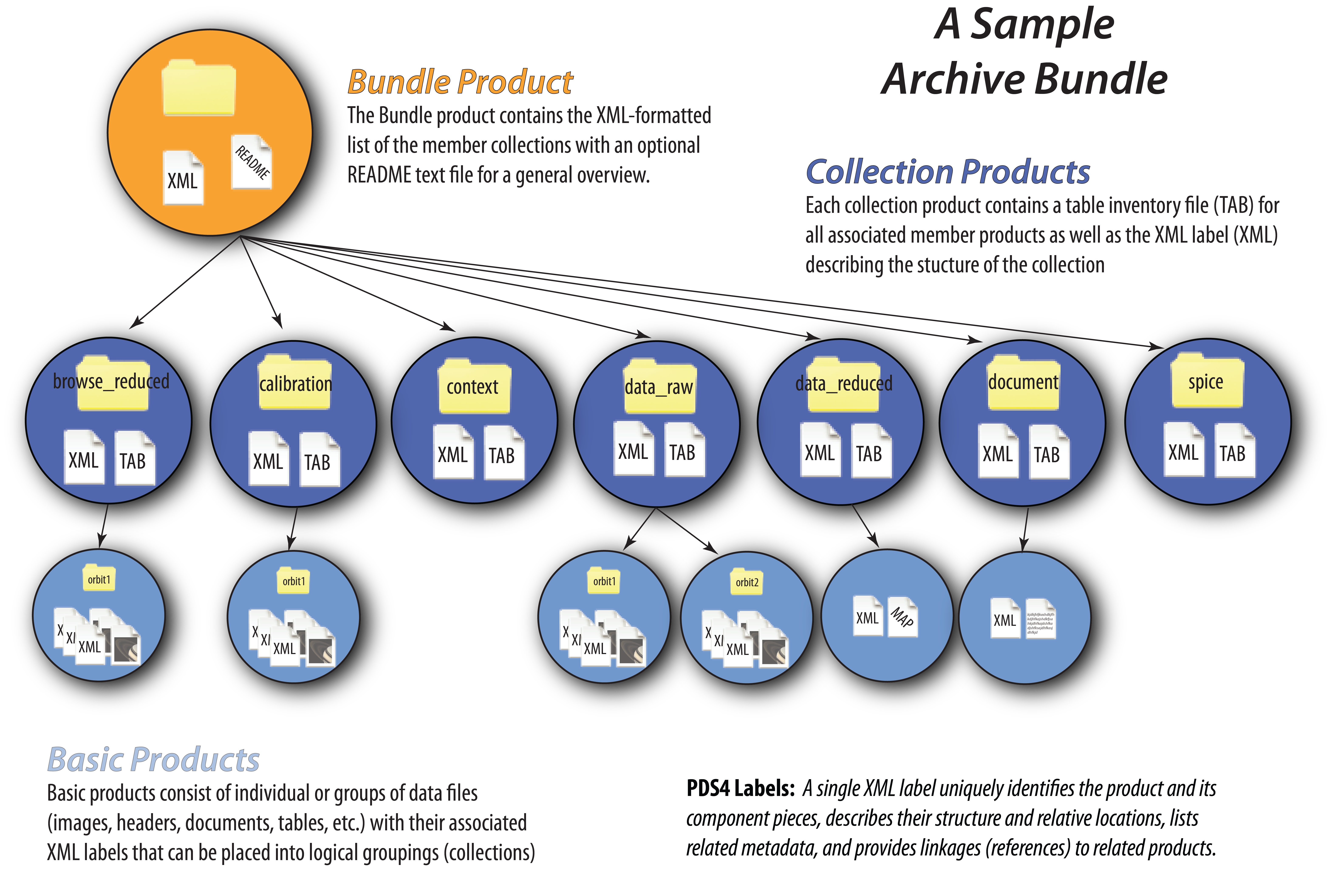Developing a PDS4 Compliant Archive in Response to the Salmon-2 PEA O Europa Instrument Investigation Announcement
This document is meant to assist a proposer who is developing a Europa Instrument in sizing and costing the development of a PDS4 compliant data pipeline and archive. The major effort in developing this aspect of a proposal will involve considering the end-to-end processing of the mission data. This includes:
- The formulation of the data pipeline
- Identifying an approach for structural and scientific validation of the data
- Documentation of instrument calibration
- Preservation of information relating to the mission's observing log that is needed to support search and recovery from the archive as well as scientific use of the data.
You will be required to design and create PDS4-compliant archives. Unlike PDS3, PDS4 is designed to take advantage of the structured data capabilities and off-the-shelf software that is available with the Extensible Markup Language (XML). Although development and construction of the XML labels is the key to constructing the mission bundles, much of the required effort will be similar to developing a PDS3 compliant archive.
This document provides a listing of factors to be included in estimating the cost of creating an archive, a listing of contacts within PDS for technical advice while preparing a proposal, reference to a proposer's archiving guide and a brief explanation of PDS4 data structure.
Costing the Data Preparation, Validation and Archiving
The costs that will be incurred for preparation, validation and archiving of PDS4-compliant data will depend on several factors, including the complexity of the mission and the heritage of science operations and instruments. The following check list (Table 1) summarizes major factors to consider in developing and estimating the cost of creating a data archive for the Planetary Data System (PDS). These elements should be described in a Data Management and Archive Plan as part of your proposal.
Table 1. Check List for Developing and Costing of a Data System
|
Check List for Developing and Costing of a Data System |
|
|
Science Operations Center (SOC) - not yet defined |
|
|
Individual Instrument Teams |
|
|
1. Definition of raw and processed data products |
|
|
2. Estimation of needed calibration activities |
|
|
3. Estimation the data volume and complexity |
|
|
4. Pipeline development |
|
|
5. Use of PDS4 validation software |
|
|
6. Scientific validation by team members using the data to be archived |
|
|
7. Development of archival documentation |
|
|
Interaction with the PDS |
|
|
1. Development and review of data plan and documentation |
|
|
2. Review of the design of pipeline products |
|
|
3. Establishment of a delivery schedule |
|
|
4. Peer review |
|
|
5. Lien resolution |
|
|
Staffing |
|
|
1. Estimation of adequate staffing and resources to process the data |
|
|
2. Estimation of required staffing for science teams to complete data development and archiving activities |
|
Contacting the Appropriate PDS Personnel
Each team is responsible for presenting an archive plan and accompanying budget. Consideration of simplified data structures with the required detached XML labels is advisable. If needed, PDS staff members are available to provide technical advice. Table 2 lists PDS staff members involved in developing the LADEE and MAVEN mission archives that are required to be PDS4 compliant.
Table 2. PDS Personnel Who Can Provide Technical Advice
|
Nodes that are Involved in Developing PDS4 Mission Archives |
Personnel to contact |
|
Navigation and Ancillary Information Facility (NAIF) |
Chuck Acton, charles.acton@jpl.nasa.gov, 818-354-3869 |
|
Atmospheres |
Reta Beebe, rbeebe@nmsu.edu, 575-646-1938 |
|
Planetary Plasma Interactions |
Ray Walker, rwalker@igpp.ucla.edu, 310-825-7685 |
|
Engineering |
Dan Crichton, daniel.j.crichton@jpl.nasa.gov, 818-354-9155 |
If in doubt, please contact the PDS Program Manager: Tom Morgan, thomas.h.morgan@nasa.gov, 301-286-1743
If you are selected for a Phase A study
The PDS staff will review the selected missions and determine which node will lead the archive development and what supporting nodes will be involved for each mission. During the Phase A period, you should interact with the appropriate lead node to refine your archiving plans and define a delivery schedule to allow a valid assessment of this component of your mission.
Basic Steps for Planning and Preparing a Dataset are:
- Gaining a preliminary understanding of a PDS4 data bundle
- Working with PDS nodes to design products and labels
- Creation of archive products, collections and bundles
- Submission of products, collections and bundles to PDS
- Peer review of the products, collections and bundles
The PDS4 System
The PDS has developed the PDS4 system to streamline the ingestion and distribution of archived data and to take advantage of the structured data capabilities and off-the-shelf software that is available with the Extensible Markup Language (XML). A useful resource, the Mission Proposer's Archiving Guide (MPAG), is available at https://pds.nasa.gov/documents/pag/Mission-Proposers-Archive-Guide-v4-r5.pdf
Contents of a PDS4 Data Bundle
Data in PDS4 are organized into a hierarchical structure of bundles, collections, and basic products. Bundles contain logical groupings of related collections and collections contain logical groupings of related basic products (See Figure 1.) Collections may include: context information (target, spacecraft, instrument, etc.), documentation for usage of the data, science data (raw, calibrated, derived), calibration information, and linkages to XML schema and schematron (blueprints and sets of rules) used in the generation of the label files. Development and construction of the labels is the key to constructing the mission bundles.
An example bundle (with labels) can be found at http://atmos.nmsu.edu/PDS4BETA/phoenix/met.htm. If you have questions, seek help from your PDS contact (See Table 2.)

Figure 1. Structure of a PDS4 Data Bundle
 PDS: The Planetary Data System
PDS: The Planetary Data System
